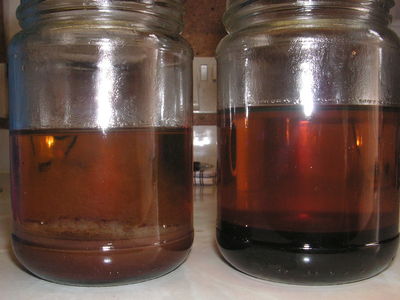Water prewash
Introduction

A water prewash is a way to stop the biodiesel transesterification reaction and reduce the soap content of the processed biodiesel. This makes further washing easier as it reduces the chance of forming emulsions.
Water is added to the processor and mixed while the glycerol byproduct is still present in the mix. When the glycerol is drained, the water comes with it leaving relatively dry biodiesel.
Contents
Advantages and disadvantages of water prewashing
Washing has traditionally been thought of as one of the more challenging, time-consuming aspects of making biodiesel. Water prewashing makes biodiesel much easier to wash afterwards, and reduces the overall amount of wash water required.
The disadvantage is that the drained glycerol will contain most of the water, which makes methanol recovery difficult - it is unlikely that the resulting methanol will be pure enough to reuse. In addition the remaining biodiesel will be slightly damp, so methanol recovery from that will also produce methanol that may not be pure enough to reuse. Neither of these disadvantages are a concern, however, if you don't plan to recover methanol as part of your process.
The more water added, the more soap is removed - but also more byproduct is produced. Beyond 7% (of the original oil volume) little extra soap is removed. Many homebrewers use 5% water washes.
Water prewashing can also be used prior to settling and dry washing the fuel, though the benefit of doing this is not so clear.
How to water prewash
Start by running the biodiesel reaction in your processor as normal. Process as usual until your batch is finished, but before turning off your pump or mixer, add in the 7% water prewash and continue mixing. Here are the details for the two most common base reactions:
Single stage base reaction
Process as usual until your batch is finished but keep your pump or mixer running.
With your pump or mixer still running, add 7% water (that's 70ml of water for every litre of oil being processed - not including methoxide).
After you have added in the 7% water, continue pumping/mixing for an additional 15 to 20 minutes.
Two-stage 80/20 base reaction
Process as usual until your batch is finished but keep your pump or mixer running. With your pump or mixer still running, re-introduce the glycerol you drew off at the end of Stage 1 back into your processor PLUS 7% water (that's 70ml of water for every litre of oil being processed - not including methoxide).
After you have added in the Stage 1 glycerol PLUS the 7% water, continue pumping/mixing for an additional 15 to 20 minutes.
When you are finished mixing the prewash, settle the batch as usual in your processor or after pumping into your settling tank or wash tank.
After the batch has settled, drain off the glycerol byproduct. Now that it has 7% water mixed in with it, your glycerol byproduct will be much thinner than usual and there will be more of it.
Using your usual technique, wash your biodiesel until the wash water is clear. With the 7% water prewash you may find that you can use a faster, more vigorous washing technique with less risk of causing an emulsion. You may also find you need to wash your biodiesel just once or twice instead of three, four or five times it previously needed. This technique can save you a lot of time, water and aggravation!
Credit to Alistair (aka HCII) for determining the effects of using different water wash quantities